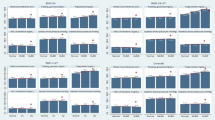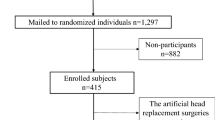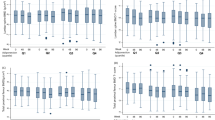Abstract
Objective: To examine whether the relation between lifestyle and metacarpal bone mineral density (BMD) varied with life-stages.
Design: Cross-sectional study.
Setting: Taking questionnaires related to lifestyle and examining metacarpal BMD by computed X-ray densitometry at a local health care center.
Subjects: Out of 750 Japanese women aged 40–69 y old who underwent screening for osteoporosis, we selected 535 healthy subjects without medical conditions or lifestyle factors known to affect bone metabolism.
Results: A cross-sectional comparison of BMD and years since menopause (YSM) resulted in a logarithmic regression model (BMD=2.539–0.149×loge YSM, r2=0.418), indicating that a prominent reduction in metacarpal BMD appears up to 4–6 y after menopause. In premenopausal women with regular menstruation, those who engaged in regular physical activity during adolescence showed significantly greater BMD than those who did not. In 1–5-y postmenopausal women, those with current calcium intake of more than 800 mg/d, current milk intake greater than 900 ml/week, daily consumption of milk and/or dairy products, or frequent consumption of small fish showed significantly greater BMD. In 6–15-y postmenopausal women, those who took more than 6000 or 8000 steps/day showed significantly greater BMD.
Conclusions: The relation between lifestyle and BMD differed with life-stages in Japanese women. It was suggested that to perform lifestyle modifications for the prevention of osteoporosis, life-stages should be taken into consideration.
Sponsorship: Grant for Research on Health Service from Ministry of Health and Welfare, Japan and grant from The National Dairy Promotion and Research Association of Japan.
European Journal of Clinical Nutrition (2000) 54, 9–13
This is a preview of subscription content, access via your institution
Access options
Subscribe to this journal
Receive 12 print issues and online access
$259.00 per year
only $21.58 per issue
Buy this article
- Purchase on Springer Link
- Instant access to full article PDF
Prices may be subject to local taxes which are calculated during checkout
Similar content being viewed by others
Author information
Authors and Affiliations
Contributions
Guarantors: KI and TO.
Contributors: KI was the lead investigator and wrote the paper. TO was the medical supervisor. MH undertook the nutritional assessment and performed data analyses. KY managed the screening for osteoporosis. ST conducted the lifestyle questionnaire. SI participated in drafting and editing the paper. All investigators were involved in the study design.
Corresponding author
Rights and permissions
About this article
Cite this article
Ishikawa, K., Ohta, T., Hirano, M. et al. Relation of lifestyle factors to metacarpal bone mineral density was different depending on menstrual condition and years since menopause in Japanese women. Eur J Clin Nutr 54, 9–13 (2000). https://doi.org/10.1038/sj.ejcn.1600884
Received:
Revised:
Accepted:
Published:
Issue Date:
DOI: https://doi.org/10.1038/sj.ejcn.1600884
Keywords
This article is cited by
-
Effects of food groups and dietary nutrients on bone loss in elderly Chinese population
The Journal of nutrition, health and aging (2011)
-
One-year change in the second metacarpal bone mass associated with menopause nutrition and physical activity
The Journal of nutrition, health and aging (2009)
-
Dietary fish oil results in a greater bone mass and bone formation indices in aged ovariectomized rats
Journal of Bone and Mineral Metabolism (2008)
-
Epidemiological multicenter study on osteoporosis: the EDMUSTO study
Rheumatology International (2007)



